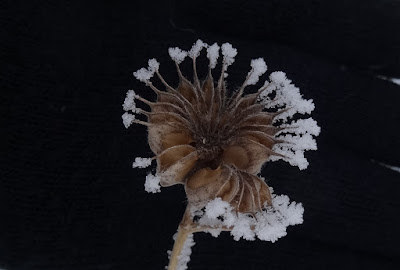Many native plants are coming up through their winter blankets of grasses and mulch. The Golden Alexanders Zizia aurea will be displaying their golden yellow flowers in just a few weeks.
4/12/2021
4/09/2021
hooded mergansers
4/06/2021
tamarack rosettes
There are several trees in the riparian area around the pond. One is the Tamarack Larix laricina or American Larch. It is just starting to flower, before sprouting its fresh bright green soft needles. Tamarack is a native deciduous conifer; it is in the pine family but sheds needles (leaves) in Autumn.
4/05/2021
lovey doves
Mourning Doves being lovey-dovey. A small flock has been here all winter, coming to the feeders for nourishment. These two hang together now since it is mating season. One was feeding the other a morsel, a sure sign of courtship. The male of this species is slightly larger than the female, and he has a pink chest.
4/03/2021
hooded mergansers
Late on this balmy Spring day, a pair of Hooded Mergansers landed on the pond. They might be migrating, needing a place to stop and rest. We watched them paddle around a bit near the far shoreline. As the sunlight dimmed, the turtles who spent the afternoon warming themselves on the rocks started swimming back into the pond. Neither species seemed to be bothered by the other. This turtle sat comfortably with the ducks for a long time, each enjoying the end of winter.
3/24/2021
junco in spring
3/14/2021
cold goose feet
3/12/2021
mallards' finest feathers
Mallards arrived this week on the pond. Last year, after nesting and before migrating, mallard ducks molted: each lost and replaced all of their feathers with new drab plumage. This is considered their 'basic plumage.' In the early spring, just before breeding season, they shed some feathers and put on their handsome 'alternate plumage' to look more attractive and help attract a mate.
3/11/2021
3/10/2021
2/20/2021
snow covered rocks
2/05/2021
winter gardening
Read more about the process at https://northerngardener.org/winter-sowing-perennials-works/
2/01/2021
1/28/2021
1/10/2021
velvetleaf
Many plants, which bloom and fruit in the warm growing season, stand bravely throughout the winter to ensure its seeds are fully distributed. This fruit capsule opened as it dried out in Autumn, and seeds have been coaxed out by the breeze. Now, it stands despite snow and hoarfrost.
Velvetleaf Abutilon theophrasti blooms in late summer with orange-yellow flowers on stems and leaves that really look and feel like they are cloaked in velvet. There were a few growing in the riparian buffer around the pond, but we pulled them because this plant is not native. It can form dense monocultures in place of native plants, suck large quantities of water and nutrients from the soil, and can inhibit germination of other plants.This in one of the plants that probably spreads from nearby crop fields, and that we try to keep out of the pond area.
12/28/2020
mourning doves
The seed feeders hang outside the deck railing. Sometimes the Mourning Doves line up on the rail, watching for their turn at the feeder. On some days they just sit here to crack and savor the seeds. We've seen ten at a time here, waiting or enjoying the food.
12/11/2020
crow
This American Crow Corvus brachyrhynchos is hunting near the frozen pond for something to eat.
It may be preparing to migrate . . . or not.Individual crows are consistent in whether they migrate or stay in the winter. Partial migration (where only some of a species migrate) might give crows enough flexibility to adapt to changing environmental conditions. Some we see in Minnesota now may have come south for the winter from Canada. Others, who breed and nest here, may have gone to Nebraska for the winter. Crows return faithfully to the same breeding territory each year.
11/22/2020
tracks, cracks, marks, mysteries
11/09/2020
temperamental autumn
11/08/2020
dabbling ducks
11/02/2020
sparrow feeding on shore
Evidently there are still damselflies or dragonflies among the reeds and grasses on the shore. This sparrow scored one while hopping in the shallow water of the pond.
10/31/2020
surviving below freezing - turtles
Since we had several cold days and nights already, Painted Turtles Chrysemys picta who live in the pond are getting ready for winter. Lacking summer heat, this one was wandering very very slowly for a food item or a place to settle. Turtles will spend the next several months in frigid pond water below the frozen ice, with their metabolism and their heart rate slowed way down. They can absorb oxygen from the water through vascularized areas in their mouth, throat, and anus (cloacal respiration). But using oxygen produces lactic acid in their body, which the turtle counteracts with minerals released from its shell and bones. Painted Turtles do not eat during this time, but they do remain alert, especially to light from above. In Spring, when the hours of daylight increase, they will respond.
10/28/2020
water sports
Sunny and warmer, closer to normal weather today, after an early snow in October. Several Mallards are getting ready for their travel south by feeding on the dwindling supply of plant material in the pond. But the resident muskrats do not like to share their food supply. We watched several encounters today between the animals.
10/24/2020
junco on snowy suet
Juncos arrived last week from nesting grounds north of here. Several made their way to our feeders. Usually, they stay in this area all winter, so it is important to locate some food sources before the snow flies. They will live on seeds from the native plants . . . and of course, suet.



























